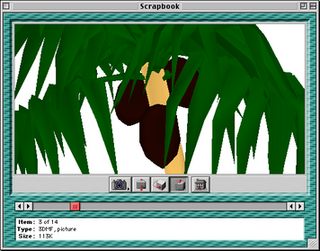Related Research Articles

Microsoft DirectX is a collection of application programming interfaces (APIs) for handling tasks related to multimedia, especially game programming and video, on Microsoft platforms. Originally, the names of these APIs all began with "Direct", such as Direct3D, DirectDraw, DirectMusic, DirectPlay, DirectSound, and so forth. The name DirectX was coined as a shorthand term for all of these APIs and soon became the name of the collection. When Microsoft later set out to develop a gaming console, the X was used as the basis of the name Xbox to indicate that the console was based on DirectX technology. The X initial has been carried forward in the naming of APIs designed for the Xbox such as XInput and the Cross-platform Audio Creation Tool (XACT), while the DirectX pattern has been continued for Windows APIs such as Direct2D and DirectWrite.

OpenGL is a cross-language, cross-platform application programming interface (API) for rendering 2D and 3D vector graphics. The API is typically used to interact with a graphics processing unit (GPU), to achieve hardware-accelerated rendering.
Direct3D is a graphics application programming interface (API) for Microsoft Windows. Part of DirectX, Direct3D is used to render three-dimensional graphics in applications where performance is important, such as games. Direct3D uses hardware acceleration if available on the graphics card, allowing for hardware acceleration of the entire 3D rendering pipeline or even only partial acceleration. Direct3D exposes the advanced graphics capabilities of 3D graphics hardware, including Z-buffering, W-buffering, stencil buffering, spatial anti-aliasing, alpha blending, color blending, mipmapping, texture blending, clipping, culling, atmospheric effects, perspective-correct texture mapping, programmable HLSL shaders and effects. Integration with other DirectX technologies enables Direct3D to deliver such features as video mapping, hardware 3D rendering in 2D overlay planes, and even sprites, providing the use of 2D and 3D graphics in interactive media ties.
OpenGL Performer, formerly known as IRIS Performer and commonly referred to simply as Performer, is a commercial library of utility code built on top of OpenGL for the purpose of enabling hard real-time visual simulation applications. OpenGL Performer was developed by SGI. OpenGL Performer is available for IRIX, Linux, and several versions of Microsoft Windows. Both ANSI C and C++ bindings are available.
OpenGL++ was a graphics library written in C++ that supported object-oriented data structures on top of the OpenGL 3D graphics system. The project started as the result of a partnership between SGI, IBM and Intel, and later, Digital Equipment Corporation. It was intended to provide a higher level API than the "bare metal" support of OpenGL, as well as being an implementation for Java3D. Work on OpenGL++ ended when SGI decided to partner with Microsoft instead, leading to the Fahrenheit project, which also died.
Open Inventor, originally IRIS Inventor, is a C++ object-oriented retained mode 3D graphics toolkit designed by SGI to provide a higher layer of programming for OpenGL. Its main goals are better programmer convenience and efficiency. Open Inventor exists as both proprietary software and free and open-source software, subject to the requirements of the GNU Lesser General Public License (LGPL), version 2.1.

A graphics processing unit (GPU) is a specialized electronic circuit initially designed for digital image processing and to accelerate computer graphics, being present either as a discrete video card or embedded on motherboards, mobile phones, personal computers, workstations, and game consoles. After their initial design, GPUs were found to be useful for non-graphic calculations involving embarrassingly parallel problems due to their parallel structure. Other non-graphical uses include the training of neural networks and cryptocurrency mining.

QuickDraw 3D, or QD3D for short, is a 3D graphics API developed by Apple Inc. starting in 1995, originally for their Macintosh computers, but delivered as a cross-platform system.
GLX is an extension to the X Window System core protocol providing an interface between OpenGL and the X Window System as well as extensions to OpenGL itself. It enables programs wishing to use OpenGL to do so within a window provided by the X Window System. GLX distinguishes two "states": indirect state and direct state.
Game programming, a subset of game development, is the software development of video games. Game programming requires substantial skill in software engineering and computer programming in a given language, as well as specialization in one or more of the following areas: simulation, computer graphics, artificial intelligence, physics, audio programming, and input. For multiplayer games, knowledge of network programming is required. In some genres, e.g. fighting games, advanced network programming is often demanded, as the netcode and its properties are considered by players and critics to be some of the most important metrics of the game's quality. For massively multiplayer online games (MMOGs), even further knowledge of database programming and advanced networking programming are required. Though often engaged in by professional game programmers, there is a thriving scene of independent developers who lack a relationship with a publishing company.
PHIGS is an application programming interface (API) standard for rendering 3D computer graphics, considered to be the 3D graphics standard for the 1980s through the early 1990s. Subsequently, a combination of features and power led to the rise of OpenGL, which became the most popular professional 3D API of the mid to late 1990s.

In computer graphics, a shader is a computer program that calculates the appropriate levels of light, darkness, and color during the rendering of a 3D scene—a process known as shading. Shaders have evolved to perform a variety of specialized functions in computer graphics special effects and video post-processing, as well as general-purpose computing on graphics processing units.

Mark J. Kilgard is a graphics software engineer working at Nvidia.

OpenGL for Embedded Systems is a subset of the OpenGL computer graphics rendering application programming interface (API) for rendering 2D and 3D computer graphics such as those used by video games, typically hardware-accelerated using a graphics processing unit (GPU). It is designed for embedded systems like smartphones, tablet computers, video game consoles and PDAs. OpenGL ES is the "most widely deployed 3D graphics API in history".
A shading language is a graphics programming language adapted to programming shader effects. Shading languages usually consist of special data types like "vector", "matrix", "color" and "normal".

OpenGL Shading Language (GLSL) is a high-level shading language with a syntax based on the C programming language. It was created by the OpenGL ARB to give developers more direct control of the graphics pipeline without having to use ARB assembly language or hardware-specific languages.
Windows Display Driver Model is the graphic driver architecture for video card drivers running Microsoft Windows versions beginning with Windows Vista.
IrisVision is an expansion card developed by Silicon Graphics for IBM compatible PCs in 1991 and is one of the first 3D accelerator cards available for the high end PC market. IrisVision is an adaptation of the graphics pipeline from the Personal IRIS workstation to the Micro Channel architecture and consumer ISA buses of most modern PCs of the day. It has the first variant of IRIS GL ported to the PC, predating OpenGL.
This is a glossary of terms relating to computer graphics.
References
- ↑ PC Magazine, December 20, 1994
- ↑ "RenderMorphics and Reality Lab History". Qube Software. Archived from the original on 2008-12-23. Retrieved 2009-01-25.
- ↑ Thurrott, Paul (July 16, 1997). "Open GL vs. Direct3D: the debate continue". Windows IT Pro. Archived from the original on February 5, 2010. Retrieved 2009-01-25.
- ↑ Thurrott, Paul (July 21, 1997). "Direct3D vs. OpenGL continues: id and Alex St. John strike back". Windows IT Pro. Archived from the original on February 5, 2010. Retrieved 2009-01-25.
- ↑ Microsoft and 3D Graphics: A Case Study in Suppressing Innovation and Competition Archived October 23, 2007, at the Wayback Machine
- ↑ "OpenGL ++ ARB Interest Subcommittee Meeting Notes". OpenGL. June 6, 1997. Retrieved 2009-01-25.
- ↑ "Silicon Graphics and Microsoft Form Strategic Alliance To Define the Future of Graphics". MOUNTAIN VIEW, Calif.: Microsoft. 1997-12-17. Archived from the original on 2009-01-22. Retrieved 2009-01-25.
- ↑ Leech, Jon (March 9–10, 1998). "ARB Meeting Notes". Salt Lake City, UT: OpenGL. Archived from the original on 2008-05-16. Retrieved 2009-01-25.
- ↑ Dana, Jenny (September 1998). "APIs of the Fahrenheit Initiative". Silicon Valley. SIGGRAPH. Archived from the original on 2007-08-07. Retrieved 2009-01-25.
- 1 2 Fahrenheit FAQ, Wayback Machine's archive of SGI's FAQ
- 1 2 "What is/was Fahrenheit?". DirectX.com. Archived from the original on 2008-04-21. Retrieved 2009-01-25.
- ↑ "HP Readies Fahrenheit Graphics Engines". Computergram International. 1999-10-19. Retrieved 2009-01-25.